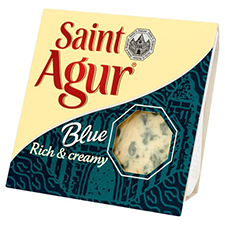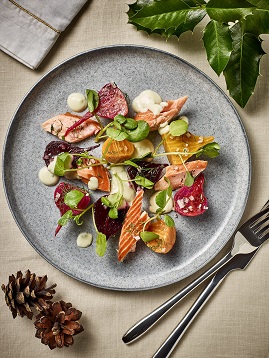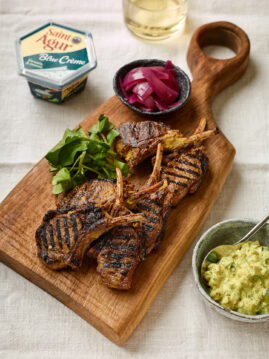For the caramelised onion
In a large bottomed saucepan with a lid on a medium-high heat, sweat the onions in the oil with a pinch of salt for 15 minutes, stirring every 3-4 minutes. Turn the heat down to low and continue to cook for a further 15-20 minutes with the lid off, stirring regularly to allow the onions to caramelise to a dark golden colour.
Once the onions are soft and dark golden, remove from the saucepan onto a tray and leave to cool.
For the dough
Lightly grease your rectangular tray with olive oil.
In a large mixing bowl, mix the flour, sea salt, rosemary and garlic. In a separate bowl, dissolve the yeast in the water.
Make a well in the middle of the flour, add the yeast mixture, half the oil and gradually mix together with your fingertips. Once the dough comes together, start to knead on a lightly floured work surface for 3-4 minutes. This will work the gluten and give the bread dough its strength and structure. Add the remaining oil whilst kneading and continue for a further 5-8 minutes. Of course, this can be done by a machine, making it easier, but I do recommend working with your hands as you learn these important skills. Place the dough back into the bowl, cover with a clean cloth and prove at room temperature for 30 minutes.
Place the dough into the oven tray and press the dough down with your fingertips to cover the base of the tray completely.
Prove at room temperature in a warm place away from any drafts, again covered with a clean cloth until it doubles in volume (this usually takes 30-40 minutes). It’s important to cover the bread with a cloth, as it will keep out any draft and prevent a crust forming.
For the topping
Pre-heat the oven to 220℃.
Lightly brush the dough with the olive oil and using your fingers create dimples in the surface of the dough.
Spread over the caramelised onions, trying not to flatten the dough. Evenly arrange the other garnishes across the dough and sprinkle on the diced SAINT AGUR®.
For baking and serving
Bake in the pre-heated oven for 25-30 minutes or until golden and crisp.
Turn the baked focaccia out of the tin onto a wire rack to cool. It’s important not to leave the bread in the tin, otherwise it will steam and the crust will not be as crisp.
Place in the middle of the table as part of a sharing starter, or with dips and crudités and let your guests help themselves.
Making focaccia is a brilliant and simple way of developing your bread-making skills. It also helps you learn about the wonders of yeast, which of course creates the magic of the fermentation within the bread.
Credits: Recipe © Raymond Blanc / Photo © Chris Terry
Special Equipment
33cm x 24cm x 5cm high rectangular oven tray
For the caramelised onion
180g white onion, sliced
1 tbsp refined olive oil
1 pinch sea salt
For the dough
1 tbsp refined olive oil, for greasing
500g strong white, bread flour, plus a little extra for dusting
2 tsp sea salt
2 sprigs rosemary, finely chopped
15g fresh yeast or 7g of dried yeast
280ml water
7 tbsp extra virgin olive oil
For the topping
10 garlic cloves, peeled, wrapped in tinfoil with 1 tbsp of refined olive oil and roasted in 160ºC oven for 30 mins
1 tin anchovy fillets, in oil, drained
100g caramelised onions (see recipe)
80g SAINT AGUR® blue cheese, diced
2 tbsp extra virgin olive oil, for brushing
2 pinches sea salt
PRODUCT

View Method
Recipe Method
For the caramelised onion
In a large bottomed saucepan with a lid on a medium-high heat, sweat the onions in the oil with a pinch of salt for 15 minutes, stirring every 3-4 minutes. Turn the heat down to low and continue to cook for a further 15-20 minutes with the lid off, stirring regularly to allow the onions to caramelise to a dark golden colour.
Once the onions are soft and dark golden, remove from the saucepan onto a tray and leave to cool.
For the dough
Lightly grease your rectangular tray with olive oil.
In a large mixing bowl, mix the flour, sea salt, rosemary and garlic. In a separate bowl, dissolve the yeast in the water.
Make a well in the middle of the flour, add the yeast mixture, half the oil and gradually mix together with your fingertips. Once the dough comes together, start to knead on a lightly floured work surface for 3-4 minutes. This will work the gluten and give the bread dough its strength and structure. Add the remaining oil whilst kneading and continue for a further 5-8 minutes. Of course, this can be done by a machine, making it easier, but I do recommend working with your hands as you learn these important skills. Place the dough back into the bowl, cover with a clean cloth and prove at room temperature for 30 minutes.
Place the dough into the oven tray and press the dough down with your fingertips to cover the base of the tray completely.
Prove at room temperature in a warm place away from any drafts, again covered with a clean cloth until it doubles in volume (this usually takes 30-40 minutes). It’s important to cover the bread with a cloth, as it will keep out any draft and prevent a crust forming.
For the topping
Pre-heat the oven to 220℃.
Lightly brush the dough with the olive oil and using your fingers create dimples in the surface of the dough.
Spread over the caramelised onions, trying not to flatten the dough. Evenly arrange the other garnishes across the dough and sprinkle on the diced SAINT AGUR®.
For baking and serving
Bake in the pre-heated oven for 25-30 minutes or until golden and crisp.
Turn the baked focaccia out of the tin onto a wire rack to cool. It’s important not to leave the bread in the tin, otherwise it will steam and the crust will not be as crisp.
Place in the middle of the table as part of a sharing starter, or with dips and crudités and let your guests help themselves.






